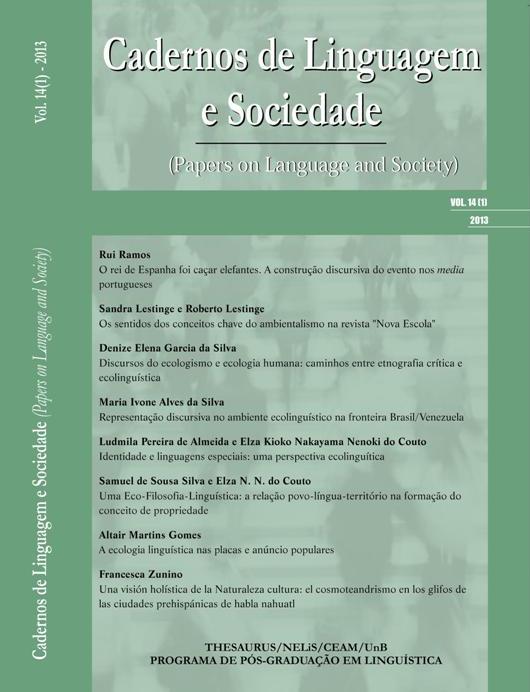DIVERSIDADE ECOLÓGICA, CULTURAL E LINGUÍSTICA REFLETIDA NO LÉXICO DE COMUNIDADES TRADICIONAIS
DOI:
https://doi.org/10.26512/les.v14i1.22237Keywords:
ity. Environment. Traditional knowledge. Minority languages.Abstract
This study analyzes the linguistic process (focus on the lexicon) that takes place in the interrelationship between traditional communities and their environment, taking into consideration among others biodiversity, cultural and linguistic diversity. Through literature review (research in traditional communities present in several locations worldwide), the research shows that these interactions not only exist; they are inextricable, as Maffi put it.
Downloads
References
BORETZKY, N. Lexikalische Natürlichkeit: Benennungsmotive in Pflanzenname. In: BORETZKY, N.; W.; ENNINGER; T. STOLZ (orgs.). Beiträge zum 3. Essener Kolloquium über Sprachwandel und seine bestmmende Faktoren, p. 53-76. Bochum: Brockmeyer, 1987.
CARLSON, T. J. Language, ethnobotanical knowledge, and tropical public health, p. 489-502. In: MAFFI, Luisa (org.), On biocultural diversity: Linking language, knowledge, and the environment, 2001.
COUTO, H. H. do. Ecolinguística: estudos das relações entre língua e meio ambiente. Brasília: Tessaurus, 2007.
MAFFI, L. (org). On biocultural diversity: Linking language, knowledge, and the environment. Washington: Smithsoniam Institution Press, 2001.
MAFFI, L. (org). Linguistic, Cultural and Biological Diversity. Annu. Rev. Anthropol. 29, 2005, p. 599”“617. Disponível em:<http://www.terralingua.org/wp/content/uploads/downloads/2011/01/ARA_review.pdf>. Acesso em 05/08/2012.
MASSAROTTO, N. P. Diversidade e uso de plantas medicinais por comunidades quilombolas kalungas e urbanas no nordeste do Estado de Goiás ”“ GO, Brasil. Dissertação de Mestrado em Ciências Florestais (inédita). Brasília: Universidade de Brasília, 2009.
MÜHLHÄUSLER, P. Ecolinguistics, linguistic diversity, ecological diversity, p. 133-144. In: L. MAFFI (org.). Washington: Smithsoniam Institution Press, 2001.
MÜHLHÄUSLER, P. Ecolinguistics in the University. Perspective of Linguistic Diversity. Adelaide: Sangensha Publishers, 2010.
RODRIGUES, A. D. Biodiversidade e diversidade etnolingüística na Amazônia. In: SIMÕES, M. do S. (org.). Cultura e biodiversidade entre o rio e a floresta, 1ª ed. Belém: Universidade Federal do Pará, 2001, v. 1, p. 269-278. Disponível em: < http://www.amazoe.org.br/textoreferencia/biodiversidade_e_diversidade_etnolinguistica.pdf>. Acesso em: 05/08/2012.
SAPIR, E. A linguística como ciência: ensaios. Rio de Janeiro: Livraria Acadêmica, 1969.
SMITH, E. On the coevolution of cultural, linguistic, and biological diversity, p. 95-117. In: L.MAFFI (org.). Washington: Smithsoniam Institution Press, 2001.



